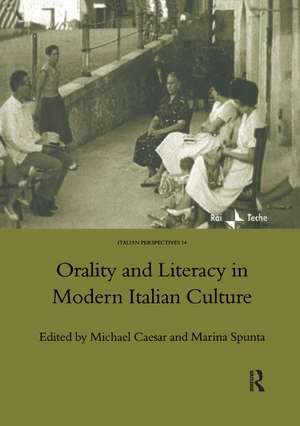Orality and Literacy in Modern Italian Culture
Autor Michael Caesaren Limba Engleză Paperback – 30 iun 2020
Preț: 178.76 lei
Preț vechi: 215.73 lei
-17% Nou
Puncte Express: 268
Preț estimativ în valută:
34.22€ • 37.18$ • 28.76£
34.22€ • 37.18$ • 28.76£
Carte tipărită la comandă
Livrare economică 21 aprilie-05 mai
Preluare comenzi: 021 569.72.76
Specificații
ISBN-13: 9780367604158
ISBN-10: 0367604159
Pagini: 184
Dimensiuni: 174 x 246 mm
Greutate: 0.45 kg
Ediția:1
Editura: Taylor & Francis
Colecția Routledge
Locul publicării:Oxford, United Kingdom
ISBN-10: 0367604159
Pagini: 184
Dimensiuni: 174 x 246 mm
Greutate: 0.45 kg
Ediția:1
Editura: Taylor & Francis
Colecția Routledge
Locul publicării:Oxford, United Kingdom
Cuprins
Introduction Part I: Orality, Literacy and Performance 1. Voice, Vision and Orality: Notes on Reading Adriana Cavarero 2. Histrionic Transgressions: The Dario Fo—Commedia dell'Arte Relationship Revisited 3. Le poetiche del 'teatro narrazione' fra 'scrittura oralizzante' e oralità-che-si-fa-testo 4. Composing, Reciting, Inscribing and Transcribing Playtexts in the Community Theatre of Monticchiello 5. An Oral Renarration of a Photoromance, 1960 6. Identità locali e giochi popolari in Italia tra oralità e scrittura Part II: Writing Orality 7. The Facets of Italian Orality: An Overview of the Recent Debate 8. Literature and Youth in the 1990s: Orality and the Written in Tiziano Scarpa's Cos'è questo fracasso? and Caliceti and Mozzi's Quello che ho da dirvi 9. Note su oralità e narrazione inattendibile 10. Voice and Events in Manlio Calegari's Comunisti e Partigiani: Genova 1942–1945 11. Oralità o stile? La trasmissione orale e le modalità narrative ne La Storia di Elsa Morante 12. Orality, Microhistory and Memory: Gesualdo Bufalino and Claudio Magris between Narrative and History
Descriere
This book lays more emphasis on orality as source, as process or performance, as outcome. It looks at the primacy of the spoken language that seems to be the main common feature to these two phenomena of Italian theatrical culture.
